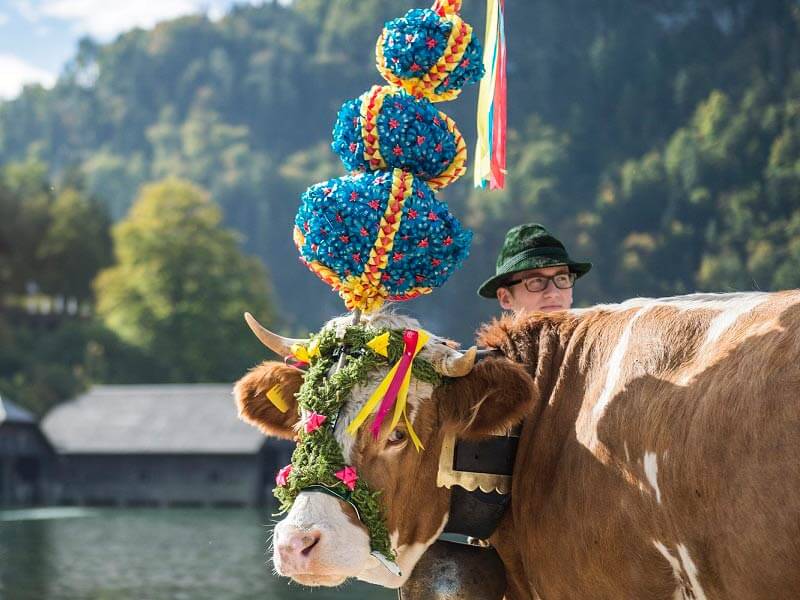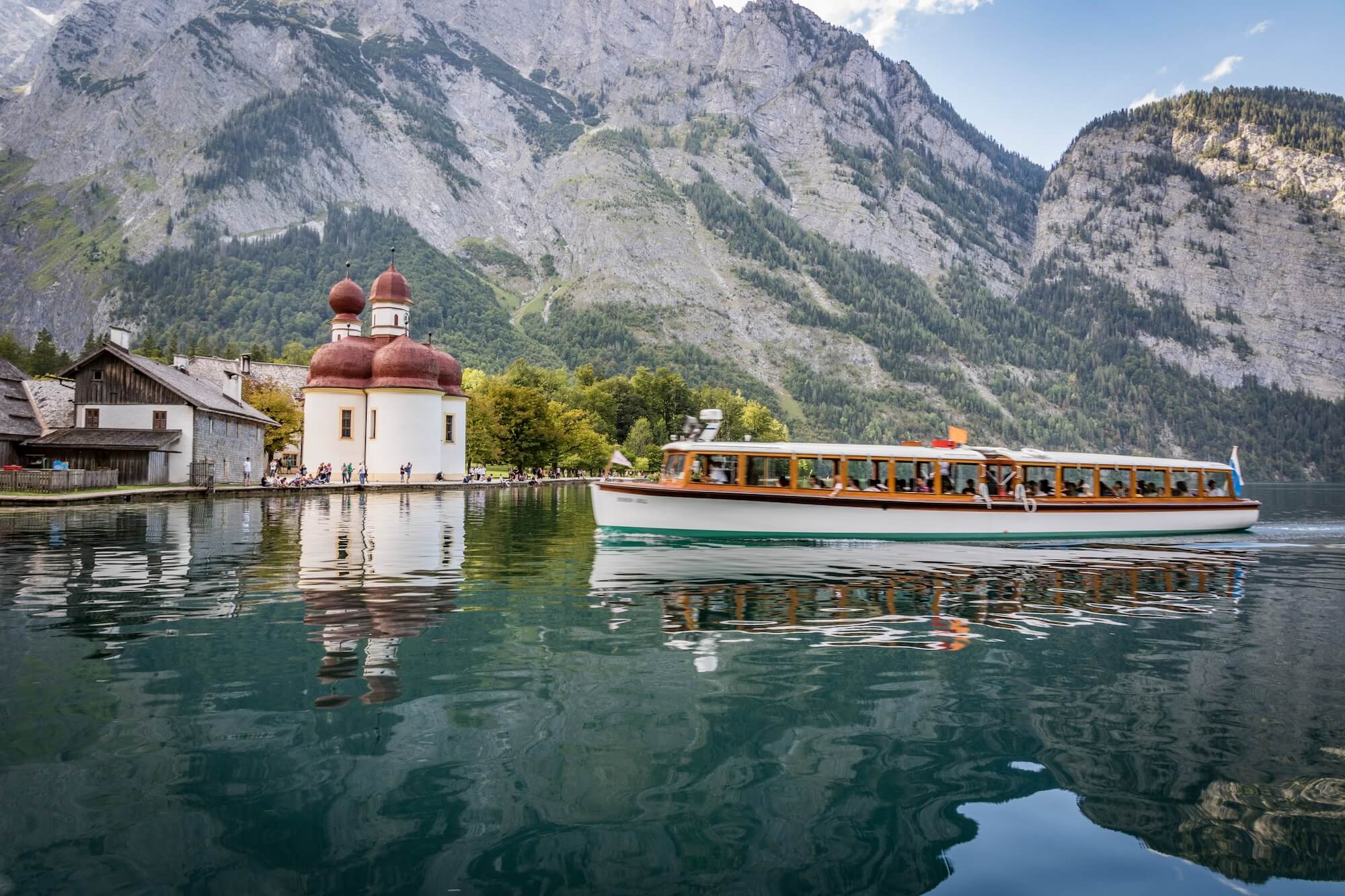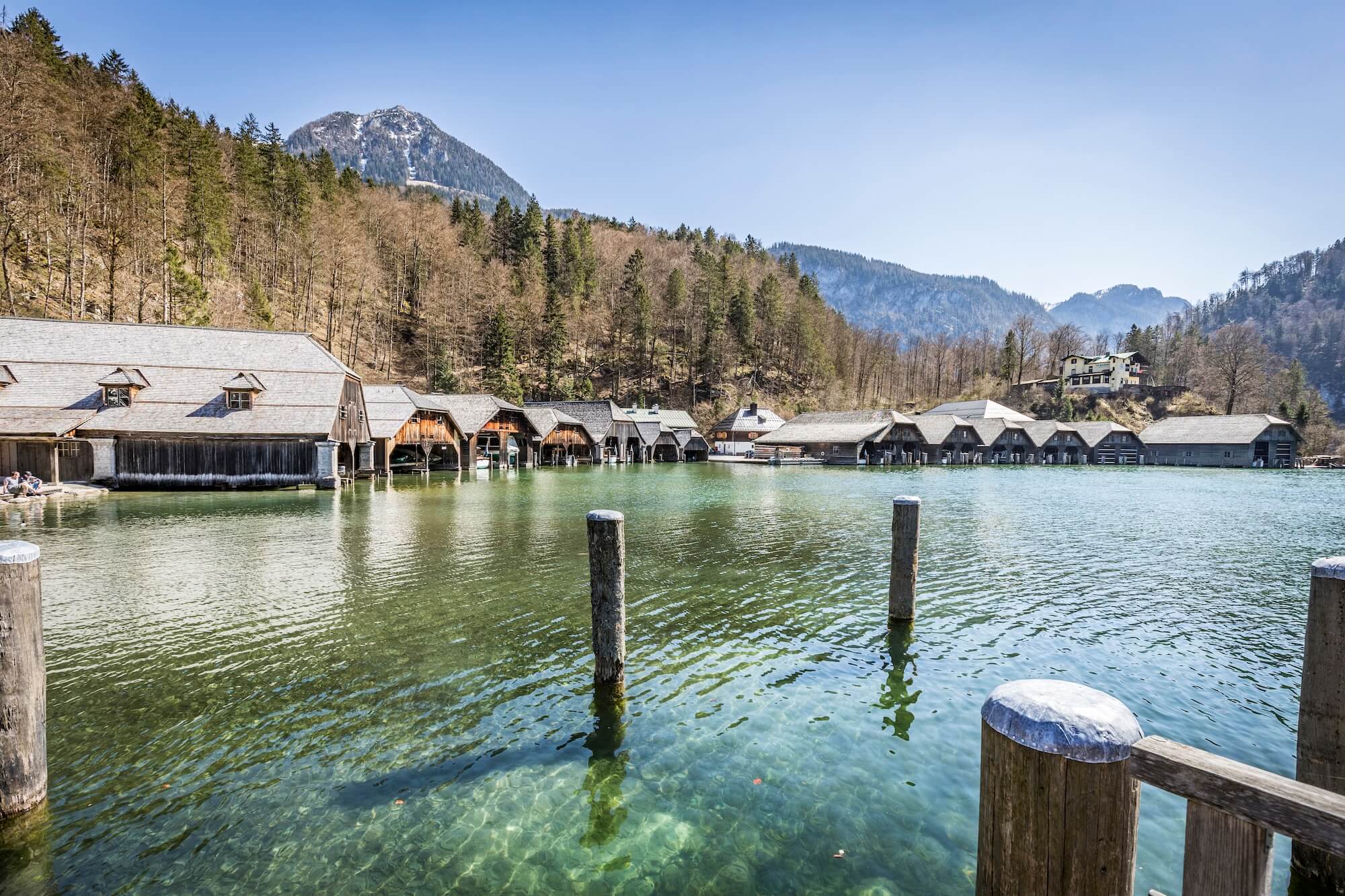
The stories behind Lake Königssee
Read on to understand to understand how tourism on lake Königssee has evolved over the years and why there’s a Volkswagen Beetle at the bottom of the lake…
- 1. Boats on lake Königssee: A long tradition started by early visionaries
- 2. Tourism at lake Obersee and the Saletalm
- 3. A brief history of the chapel of St Bartholomew
- 4. The Berchtesgaden-Königssee railway
- 5. The sunken Volkswagen Beetle
- 6. Unexpected guests cross Lake Königssee: Almabtrieb
- 7. The waters of Lake Königssee remain drinkable, despite millions of tourist visits
- 8. The Schönau am Königssee bobsleigh run: A world first at Lake Königssee
1. Boats on lake Königssee: A long tradition started by early visionaries
Gliding away from the boat piers, you are starting a journey across one of Germany’s deepest, purest and most picturesque lakes. Whilst you today travel courtesy of battery-powered electric boats, boating on the lake goes back centuries and started with sheer manpower alone.

At the end of the 1800s, around 200 oarsmen worked for the lake Königssee boating company. They catered for the thousands of visitors who came to make the same journey as you do today, with a total of 57 rowing boats carrying almost 80,000 visitors a year.
This changed in 1909 when electric boats, and an electric railway from Berchtesgaden to Königssee, were introduced by royal decree.
The new electric boats appeared in July 1909. The first to set sail was the Accumulator, making its maiden voyage on the 15th of July with 38 passengers, silently gliding across lake Königssee to the St Bartholomew peninsula. These new boats were built by German firm Siemens-Schuckert and were only around half the size of the one you ride in today.
Since 1909 the boats of lake Königssee have safely carried over 45 million passengers to the St Bartholomew peninsula and beyond.
The Bavarian Lake Shipping Company has operated the current group of 17 identical boats since 1997. In contrast to those original manned boats, these now transport around 600,000 passengers across the lake each year.
2. Tourism at lake Obersee and the Saletalm
Believe it or not, tourism at lake Obersee began with a wedding gift from the then 91-year-old Bavarian Prince Regent to a couple from Berchtesgaden.
In 1912, a young couple from Berchtesgaden were to marry and their wish was to start a tourist kiosk on the Saletalm meadows. The only hurdle was the need to gain permission from the then 91-year-old prince regent Luitpold of Bavaria.
The prince granted the couple permission on their wedding day and allowed them to build a small timber kiosk. They then began their married life together on the Saletalm.

With the construction of the kiosk and boatloads of tourists on a daily basis in the summer, it wasn’t long before a guesthouse was added in 1936. Between 1952 and 1958 the kiosk became a fully-blown tourist destination, with electric lighting, beer cellar, telephone and staff accommodation. The large building you see before you today (Alpengaststätte Saletalm) was built in place of the original kiosk in 1966.
But if you stop here, you’re missing the best part of the Saletalm. Walking past the Alpengaststätte Saletalm and following the gravel path for around 10 minutes brings you to what is you perhaps one of the most photographed views in all of Bavaria: the magnificent mirror-like view over lake Obersee.
Legend has it that it was a rockfall in 1172 that actually separated this lake from lake Königssee. Although the small distance between the two lakes supports this story, experts agree that the two lakes have most likely always been separated. At a maximum depth of 51 meters, lake Obersee is by no means as deep as lake Königssee, which is over 190m deep at some points.
Standing next to the fisherman’s hut you’ll also see the Röthbach waterfall in the far distance. This is in fact Germany’s highest waterfall, with a drop of over 490m.
3. A brief history of the chapel of St Bartholomew
With domes that wouldn’t look out of place in St. Petersburg, the Chapel of St Bartholomew is one of the most remote – and most photographed – chapels in Germany.
There has been a chapel on lake Königssee since 1134, built by the Berchtesgaden Prince-provosts. These were the leaders of the Monastery in Berchtesgaden, and from 1134 until 1803 they used the entire St Bartholomew peninsula as their own private residence.

The Prince-Provosts built and dedicated the chapel to St. Bartholomäus, the patron saint of alpine farmers and milk maids. According to accounts of the time it was a modest building, with a spire instead of the domes we see today.
During their long reign, the Provosts improved the chapel and surrounding buildings as the wealth of the monastery in Berchtesgaden grew. Almost everything you now see in front of you is the result of work that took place in 1697.
Strangely, though, what you see today looks more like St Basil’s cathedral in Moscow than what you would imagine an alpine chapel to look like. This is due to the preferred style of the architects and craftsmen the Prince-provosts chose for the work in 1697.
As you make your way along the lakeside path, you will notice the huge extension of the chapel. Believe it or not, this extension was actually a hunting lodge also built by the Prince-provosts.
From 1910 onwards, thanks to the Napoleonic Wars, the Bavarian Royal Family took control the St Bartholomew peninsula, replacing the Prince-provosts.
The hunting lodge was upgraded to the status of a royal hunting lodge and you can still see their regal hunting trophies inside. Entering through door opposite to the beer garden, you’ll see that the hallway and ground floor are still decorated with skulls and antlers from this period.

The keenest hunter of them all was Prince Regent Luitpold of Bavaria, who reigned from 1886 to 1912. His hunting trips were often disrupted by the noise of the petrol-powered boats of the time as they passed the peninsula. To keep the noise down, Luitpold made sure that by 1909 most of the boats on lake Königssee were electric. Finally, he could hunt in peace.
Luitpold’s passion for hunting is in fact the main reason that your boat to St Bartholomew today is also electrically powered! What he would make of the other 600,000 visitors to the peninsula each year, however, is anyone’s guess.
4. The Berchtesgaden-Königssee railway

Over a hundred years ago, a railway line from Berchtesgaden to lake Königssee once brought tourists – and electrical power – to the lake. Today the railway is gone, but its path remains for those who wish to walk it.
Not far from the car park at lake Königssee is an art deco building with columns and a clock tower, which reveal it was once in fact a railway station.
From 1909 to 1965 tourists could enjoy the mountain breeze as they sped along the railway line between Berchtesgaden and lake Königssee. The line itself was only 4.3 kilometres long (2.7 miles) but was key in getting tourists to visit the lake in a time before cars for the masses.
Construction of the railway link between Berchtesgaden and the lake was approved in August 1908 by the Bavarian State Government, since they knew that the new electric tourist boats would soon be running. Thanks to the relatively short distance, the line was formally opened just eight months later, on the 29 May 1909.
From the beginning the line was electrified, using an overhead line which also served the local railway to Salzburg. Something very few people know is that this power line was also used to re-charge the electric boats at lake Königssee overnight. It was no coincidence that the railway line and electrically powered boats were introduced at the same time.
The family car meant the end of the boom-years for the trainline and so the state stopped investing in the line from the late 1950s.
With passenger numbers still falling, the service ran until the beginning of winter in 1965, when on the 2nd of October the very final train ran.
That it was the last trip was not publicised, and it was only in the spring of 1966 that the operators finally announced the full switch to busses from trains.
The tracks were removed in the spring of 1971; however, you can now enjoy a small part of the former railway line by walking or cycling the path between Berchtesgaden and Königssee.
5. The sunken Volkswagen Beetle
Lying at the bottom of lake Königssee is a mystery. A mystery that began in 1968 and was only solved nearly 30 years later…
Picture the scene: It’s the evening of the 28th January 1968. JH from Salzburg has braved the icy weather to visit his partner who is working on the St Bartholomew peninsula. He sets off from Salzburg in his Volkswagen Beetle.
Low temperatures at this time of year mean that the lake has almost entirely frozen over, with ice as thick as 40cm (16in) in some places. Residents are usually allowed to walk and drive over the lake in these conditions, however, tonight, driving on the lake is forbidden as the ice has already started to melt.
Despite the ban, JH finds an alternative route onto the lake and makes the most of the clear ice ahead of him, driving through the crisp night to the St Bartholomew peninsula…
But On the morning of the 29th January, local Berchtesgaden residents pick up their morning papers to headlines of tragedy on lake Königssee.
On his return journey from St Bartholomew, JH had disappeared.
A search by police discovered his tyre tracks, following them to a break in the ice. There were no signs of skid marks or swerving, instead, it seemed that JH had accidentally driven off the ice and into the freezing waters of the lake.
Neither JH nor his Volkswagen Beetle were found. It was only thanks to a scientific study of the lake floor in 1997 that they were eventually discovered, lying on the lake bed close to the Falkenwand.

JH’s family decided to let the vehicle and driver rest in peace at the bottom of the lake. With the purity and low oxygen content of its waters, this unusual memorial will most likely remain there for many decades to come.
6. Unexpected guests cross Lake Königssee: Almabtrieb
Every year the herds of cows who call the Saletalm their summer home make their way back to the mainland by boat. Called Almabtrieb in German, this process is steeped in history…
Whether watching you from the cool shade of the pine trees or standing in the middle of the path you wanted to take, the cows that live on the meadows around lake Obersee certainly act like they’re the masters of this remote alpine paradise.
Masters perhaps, but they are only seasonal guests. The 30-40 cows who live on the Salet meadows (Saletalm in German) are in fact only summer tourists. Come October an extraordinary process takes place where they are transferred back to the “mainland” of Schönau am Königssee, known in German as Almabtrieb.

The tradition of Almabtrieb takes place in Austria, Switzerland and Germany, but the cows of lake Königssee are a very special case indeed. The only way to reach their summer meadows is by boat – just like your journey today.
Come the first week of October, the alpine farmers meet at the Saletalm and watch over their cows as they are herded through the early autumn mist down to the shore of lake Königssee. They look on with mixed emotions as their companions of the last few months depart for another year.
Once at the shore the cows are loaded into flat-bottomed rafts known as Landau, making use of a loading ramp designed especially for four-legged sailors. Each Landau can carry around 30 cows, along with a crew including farmers and musicians in traditional local costume.
Once loaded it takes the Landau an hour to cross lake Königssee, cruising past the St Bartholomew chapel before finally reaching dry land at Schönau am Königssee.
When the Landau reach the mainland, the cows are dressed with beautiful hand-made Fuikl. These colourful hand-made headdresses represent around 60 man-hours of work each. They are typically made from pine branches intertwined with ribbons and decorative knots.
The cows wear the Fuikl mostly on their heads; mature cows receive full height Fuikl, whilst younger cows typically wear smaller pieces. Once appropriately dressed, they process majestically back to their mainland farms.
So, if you find yourself cruising on lake Königssee in early October and think you’ve had one schnapps too many, think again – you may well indeed have seen a boat load of cows passing in the other direction.
7. The waters of Lake Königssee remain drinkable, despite millions of tourist visits

Ice ages. Not the kind of thing you’d give much thought to on a hot summer’s day, but without them we wouldn’t have the jaw-dropping scenery that surrounds us right now.
Let’s rewind approximately 10,000 years: the most recent ice age is ending and much of the area today known as the Alps is in fact covered with gigantic bodies of dense frozen seawater – glaciers.
As these glaciers moved and melted, they cut deep rifts in the soft limestone rock underneath them, leaving great cuts and tears in the landscape.
These carvings are still with us today and are in fact one of the most obvious reminders of the last ice age. The U-shaped Königssee valley (presently underwater!) is one such carving, with a maximum depth of around 200 meters at its centre.
As the glacier that formed this valley cut through the limestone it also produced a huge amount of limestone dust, giving rise to a layer of fine rock and shingle which now forms the lake bed.
It’s these tiny particles of limestone present in the waters that give the lake its characteristic green colour. The water is also crystal clear thanks to its extremely low nutrient content. A few specialised types of trout and whitefish call the lake home, but very few species can survive in these waters.
An expedition in 1997 led by Marine Biologist Professor Hans Fricke discovered a number of previously unseen and unidentifiable species lurking at the bottom of the lake.
But did you know that the waters of lake Königssee are actually clean enough to drink? We’re not exaggerating. The lake holds a drinking water quality certification and the local authorities are determined to keep it that way.
An excellent example of their determination was the renewal of the lake’s sewage pipes in the 1980s. Rather than allowing organic waste from the St Bartholomew peninsula and Saletalm to be discharged into the lake, the authorities built a 7 kilometre (4.3 mile) long sewage pipe back to the mainland to ensure that no sewage made its way into lake Königssee.
So, thanks to the almost exclusive use of electric boats on the lake since 1909 and continued efforts to minimise the human impact on the lake, we can enjoy this glacial lake as nature intended – right down to re-filling our water bottles.
8. The Schönau am Königssee bobsleigh run: A world first at Lake Königssee

Tucked away in the western corner of Schönau am Königssee is a world first which helped to almost bring the Winter Olympics to Berchtesgaden in 2018…
Completed in 1968, Schönau am Königssee is home to the world’s very first artificially refrigerated bobsled, luge and skeleton track.
Today branded as the Deutsche Post Eisarena Königssee, the original track from 1968 has been refurbished several times over the years. Athletes tackling the world-class course you see today have to master 18 curves over 1640 meters (5380 feet), including a 320° loop known as the Turbodrom – all at speeds of up to 125kph (77mph).
The track is remains one of the world’s most challenging and regularly hosts both European and World Championships.
In 2007 it was announced that Munich would be putting forward a bid to host the 2018 Winter Olympic games, alongside strong rival bids from Pyeongchang in South Korea and Annecy in France.
As part of the bid the track at Schönau am Königssee was to host the bobsled, luge and skeleton events. Many local residents, however, warned of the negative effects the games would bring, especially the potential impact on the natural environment.
As you may already know, in July 2011 it was announced that Munich had lost the bid. Pyeongchang was to host the 23rd Winter Olympics, but the track at Schönau am Königssee still hosts European and world championships to this day.
If you’d like to try it yourself, a Bobsled experience can be booked. Further information and booking details can be found HERE.

